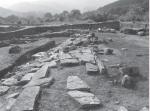Summary (English)
ARCHAEOLOGICAL EXPLORATIONS IN PRESLAV (Zhivko Aladzhov – naim@naim.bg) The explorations of the street, which connects the southern square in front of the Patriarchate of Preslav with the aristocratic building complex situated to the south, continued. The street is 1.92 m wide and was traced out at 40 m in length. A building 8 m in width, consisting of parallel rooms arranged in a line, is situated to the east of the street. The building was documented at 40 m in length. There is a pavement of stones in front of its eastern façade. Drainage for the water from the pavement was discovered. A Christian burial (No. 3) of the middle of the 10th century was explored over the debris of the building. A gilded bronze belt-buckle was found in the grave. The building and the pavement probably belong to a southern court of the Patriarchate. The construction of the street and the adjacent building dates to the end of the 9th or the first half of the 10th century. Probably, the construction was part of the enlargement and the reconstruction of the Citadel of Veliki Preslav. The street and the building were demolished in the middle of the 10th century, most likely, first after the capturing of the city by the army of Kievan Rus led by Prince Sviatoslav I and later, after the invasion of the Byzantine army led by Emperor John I Tzimiskes. Several pits for garbage collection cut the debris from the building. A pot of the end of the 12th century was discovered over a pit. The pot contained remains from cooked peas and carbonized wooden spoon of ash. Two semi-dug sunken-floor houses of the 12th – 13th centuries were discovered. The finds from the archaeological excavations include scyphate copper coins of the 13th century, lead seals of the 11th century, sherds, nails, rings, tools, fragments of architectural decoration of marble and limestone, window glass, etc.
- Zhivko Aladzhov - Archaeological Institute with Museum
Director
Team
Research Body
- Archaeological Institute with Museum






![Download [PDF]](/excavation/skins/fasti/images/results/download_sml.png)
